5 easy wildlife garden tips – they’ll really make a difference
Easy wildlife garden tips are the things you can do to make your garden more wildlife friendly without having to change anything major. And they will really help the wildlife in your garden.
I recently interviewed landscaper and wildlife garden expert Joel Ashton. He’s the author of Wild Your Garden and also has a YouTube channel called Wild Your Garden. He advises people on how to make their gardens wildlife friendly, with ponds, ‘nectar borders’, planting and design. His company, Hazelwood Landscapes, also carries out the work.
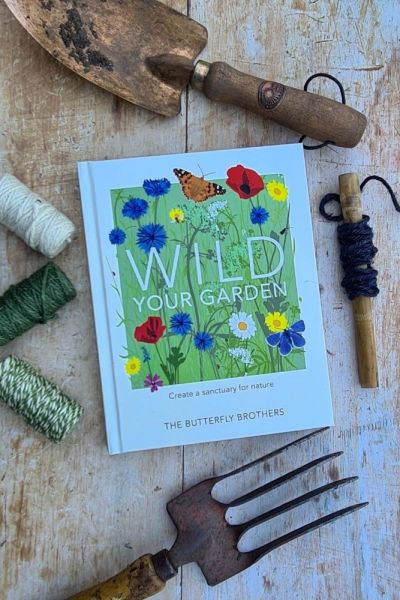
Wild Your Garden by Joel Ashton covers all aspects of creating a wildlife friendly garden. Links to Amazon are usually affiliate, but this is from Joel’s website, Hazelwood Landscape, so it is affiliated to that rather than the Middlesized Garden.
Why rewilding your garden is good…
The reason why it’s important to have a wildlife friendly, more natural garden is that insects are at the bottom of the food chain. And we’re at the top.
If too many insects disappear – and they’re are disappearing at an astonishing rate – then there are serious implications both for the pollination of our food crops and for the rest of the food chain.
As habitats get built on or changed, wildlife -especially insects and birds – lose places to shelter, eat and drink.
And if those places get too far away from each other, then biodiversity is damaged even further, because birds, insects and small mammals can’t move around or reproduce easily.
So domestic gardens can create wildlife friendly ‘corridors’. That means that wildlife can fly or move from one source of food and shelter to another, even if each is not very large.
You don’t have to dig things up, chop things down or take things away
As Joel says in Wild Your Garden, you don’t have to make dramatic changes; ‘It’s always best to work with existing features. Even a single mature tree is an invaluable asset to both local wildlife and the environment….mature trees hold onto the carbon that they took in while they grew. If they’re chopped down, they release that carbon into the atmosphere.’
So your tree may not be the one you’d have chosen if you were planting a wildlife-friendly tree from scratch. But if it’s a mature tree, it’s playing its part. The best thing you can have in your garden is a native tree, indigenous to your area.
But the second best thing is to have a mature tree – of any variety. I would never choose to plant a Leylandii cypress in my garden, but there is one that has been here for about 40 years. It is constantly full of birds of all kind, nesting and sheltering.
If you’re interested in gardening for the environment, then here are 16 ways to create an easy sustainable garden.
Easy wildlife friendly tip 1: use your vertical space
Joel says that the easiest thing to do for wildlife in a small town garden is use your vertical space for growing.
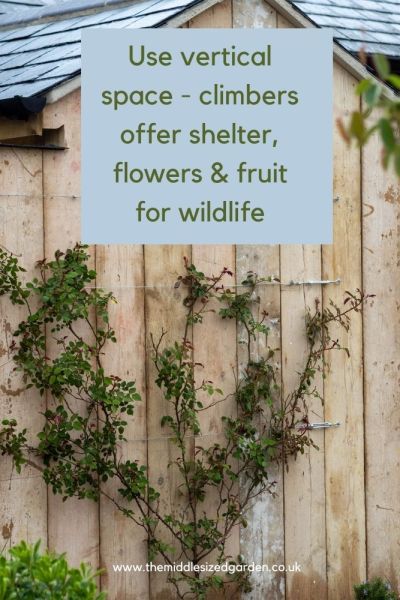
Use fences and walls as growing opportunities. Climbers offer shelter for birds and flowers for pollinators.
If you have a hedge, keep it. Don’t replace it with a fence.
But many urban gardens already have fences or walls. Joel advises you to use that vertical space by adding climbers.
This is also a classic small garden design tip, too, because if you have a climber or tree going up, it draws the eye upwards. The garden will feel bigger because it takes the eye longer to take everything in. If your climber has fruit or flowers, both you and the wildlife can enjoy them. And climbers create shelter for garden birds.
There’s a post here about how to choose the best climbing plant for your garden.
In my garden, I’ve been considering the options for a difficult shady corner. Joel told me that hops are a good climber for a north facing wall. And he added that it would provide shelter for birds in the summer and is a host to the Common Butterfly.
I’ve now bought one from Joel’s Wild Your Garden site, where he also sells a selection of wildlife friendly plants and accessories.
Tip 2: Site nest boxes and feeders correctly
There are lots of pretty bird boxes and bug hotels for sale. But not all are the right shape and size. Some are simply decorative and won’t help wildlife, because they are too big, too small or otherwise designed wrong.
It’s best to buy the boxes from somewhere which has expertise in choosing the right sizes and styles, such as Wild Your Garden or a registered wildlife charity. There’s advice on bird box sizes and positioning in Wild Your Garden, too.
Joel explained that it’s best to site bird boxes on north and east facing walls so that chicks don’t get too hot in summer. So my difficult shady corner is an ideal spot for a wildlife haven!
We’ve now hung a selection of nest boxes – perhaps too many and too close for them all to be occupied, but we’ll see which ones the birds prefer.
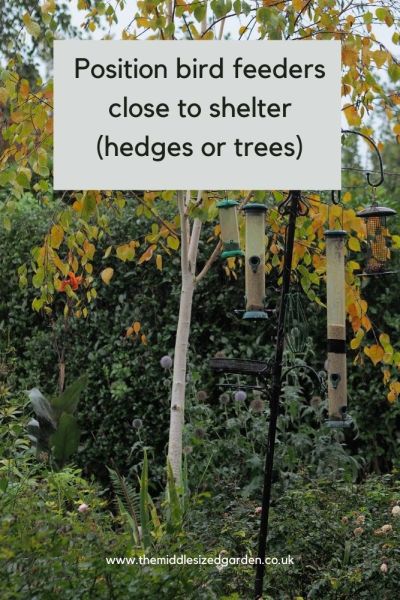
Bird feeders and nest boxes for bats, birds and insects need to hung in the right part of the garden. Check Wild Your Garden or wildlife charities to make sure you’ve got the right dimensions and materials, too.
Bat boxes need to be hung at least 3 metres from the ground, facing south or west. So that’s different from bird boxes. If you suffer from mosquitoes, bats will eat thousands in a night, so attracting them with bat boxes is really worth thinking about.
The easy wildlife garden tip you absolutely must do
Have some kind of water source or pond, no matter how small your garden is. Even mini ponds help, although you’ll need to keep them topped up in dry, hot weather.
But be aware of the safety of babies and toddlers when choosing and siting ponds. Always put safety first.
Water is essential to all living things. Joel says that once you have some water, all kinds of birds, pollinators and other wildlife will discover it.
There’s instructions on making a mini pond from an oak barrel here. And there are some good design ideas for garden ponds here.
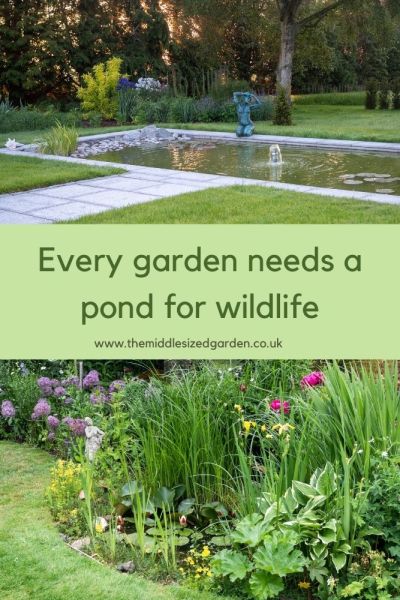
The top photo shows a beautiful formal garden pond in a private garden. The photo beneath it shows a mini pond carved out at the front of a border. Both invaluable to wildlife!
You can even have quite a large pond in a small garden. Anne Vincent’s narrow urban garden is around 20ft x 80ft. Her son was doing an environmental science degree, and persuaded her to have a wildlife friendly garden built around a pond that takes up around a quarter of the garden. This is fed with rainwater from the roof. It is a beautiful space and really does attract wildlife. This post explains it and says more about how to create a very wildlife friendly garden in a small space.
And leave the mower in the shed…
Joel would like us to leave our lawn mowers permanently in our sheds. I think that most of us would prefer a halfway house of mowing less often.
I first heard about mowing less often when I interviewed head gardener, Jane Moore, author of Planting for Butterflies. She said that leaving your lawn for two weeks rather than mowing it weekly has benefits for wildlife.
But you can leave most of the lawn longer with some paths cut through it, like in this mini meadow lawn here. However, do be aware that meadow lawns require some management. They’re not difficult and they’re not hard work, but it’s worth finding out more about them if this is a look you like.
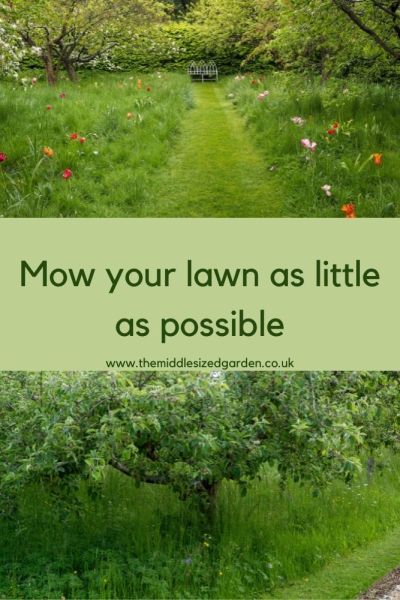
Both these are lawns allowed to grow wild. They have a path or edge that is mown to give some definition to the look.
Joel’s landscaping company, Hazelwood Landscapes, has installed over 150 ponds and meadow lawns, so I asked for his advice on dealing with the top meadow lawn mistakes here.
Easy wildlife tip 5 – provide access to other gardens or the outside world
In the past, hedges and fences had gaps at the bottom. Hedgehogs, frogs and other wildlife could roam between territories.
Today’s fences have solid concrete ‘gravel boards’ at the base. If your fence is like this, find a place where you can have even a small hole cut, or make sure that a hedgehog or similar could get under your gate.
It doesn’t matter if your garden is small, provided wildlife can get in and out of it easily. One of the most wildlife friendly gardens I’ve written about it is a narrow, north-facing town garden, where really quite small holes at the bottom of fences and hedges make all the difference to the biodiversity. It is a really charming garden.
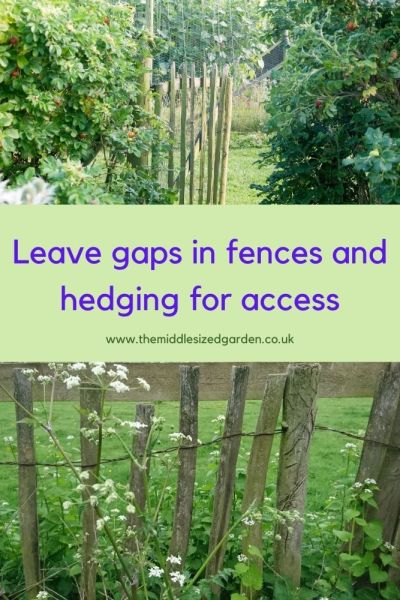
In fact, your fences and gates don’t need to look rustic, as long as there is a small gap at ground level so that wildlife can get in and out.
See Joel’s easy wildlife garden tips on video
You can see the full interview and more wildlife garden examples in this video.
Pin to remember easy wildlife garden tips
And do join us for a free weekly email with tips, ideas and inspiration for your garden.
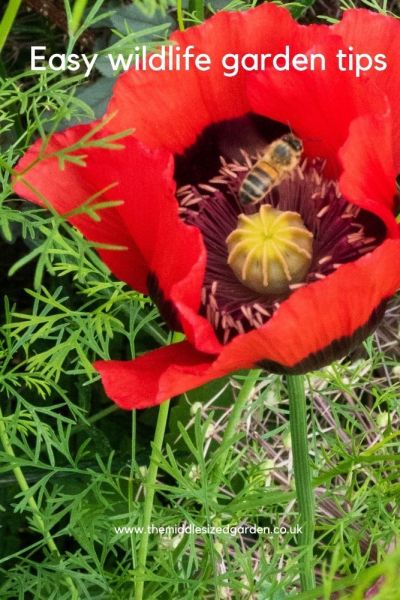

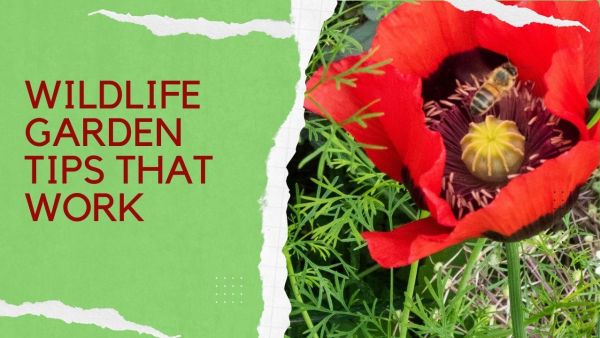























I live in Vienna, Austria and have a small garden. A friend gave me 2 small pots of crocus bulbs recently (middle January 2023), 6 bulbs crammed into each small pot, and they already have green growth (about 4 inches high). I’ve put them in my small glasshouse. Should I leave them in these pots, replant separately into larger pots, plant them in the ground or do something else? And when? Thank you.
You can either leave them in pots or plant them in the ground, if the ground isn’t frozen. Crocus generally grow well in the ground so you don’t need to plant them in larger pots unless you’d like to see them there. They’re resilient plants so you can probably do whatever you like with them (I say ‘probably’ because no plant is guaranteed to survive!)